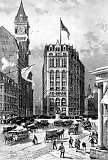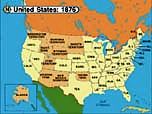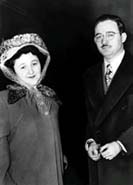
ResourceLink: 19th-Century American History and ResourceLink: 20th-Century American History. Tim O'Donnell, Managing Editor. ABC-CLIO CD-ROM, 1998.
System Requirements:
Windows 95, or Windows NT 4.0, Pentium-compatible processor running @ 75 MHz or faster, 16MB RAM, hard drive with at least 10MB free recommended, SVGA monitor (640 x 480, 256 colors), Windows-compatible mouse or pointing device, 4X CD-ROM drive, 16-bit sound card.
MAC: System 7.5.3 or later, 68040/33 MHz or PowerPC/60 MHz processor or faster, 16MB RAM, hard drive with at least 10MB free recommended, 14-in. monitor (640 x 480, 256 colors), 2X CD-ROM drive.
 |
| 19th-Century American History. From ABC-CLIO web site.
|
This CD-ROM set is promoted as a "valuable complement to classroom education for the study and teaching of U.S. history." Offering the prospect of searching, organizing, and customizing multimedia resources for public presentations and reports, it could be applied to a variety of computer-based applications, such as PowerPoint or Director.
 |
| 20th-Century American History. From ABC-CLIO web site.
|
Highly ambitious in the effort to cover two centuries of American history in only two discs, ABC-CLIO had some difficult choices to make. What topics would be included? What depth of coverage would be offered? When supplementing basic information with tables, extended texts, and moving as well as still illustrations, which subject would be so amplified within reasonable budgetary constraints?
 | New York City skyscraper,
1889. From 19th-Century
American History.
|
It should be said at the outset that this set does a reasonable job in providing breadth of coverage in its 1,490 resources for the 19th century and 1,507 for the 20th.
While content tips significantly towards government-related topics (832 and 1,114 for the respective centuries), a number of other topics broadly conceived appear, not the least environment, with 302 19th- and 210 20th-century entries. In line with contemporary scholarship, women and African Americans receive extensive treatment. Old immigrants (from Western Europe) and new immigrants (Hispanics and Asians) fare less well. Presidents receive considerable attention, even those in office relatively briefly, such as Gerald Ford. Other categories are more selective. Jack Benny is one of but a few 20th-century entertainers profiled. Babe Ruth, Michael Jordan, Joe Lewis, and Jesse Owens represent modern sports, but golf, tennis, ice hockey, and a host of other sports do not appear at all. Cities receive virtually no attention as such, with the New York skyscraper illustrated physically only by the rather strange selection of the 16th-story building constructed for The New York Times in 1889, information which is not part of the brief caption identifying the entry. In contrast, the 20th-century disc replicates each state flag, for whatever value that offers. Texts of Constitutional amendments for each century prove more pertinent.
 |
| Cartoon: Andrew Jackson's "War on the Bank of the U.S." From 19th-Century American History.
|
In the best of all worlds, the potential of the technology would be applied to its best use. Citations worthy of illustration would have them. Topics demanding in-depth treatment would be amplified through extended documents or tables, which can be read with Adobe AcrobatReader 3.0, which is part of the software package. | | The "Daisy Spot." From 20th-Century American History.
| | 28.8 | 56k
|
This happens more than a few times. Many 19th-century subjects are well illuminated through unusual still portraits, including Lizzie Borden and Jacob Riis. Some wonderful cartoons illustrate Andrew Jackson's "War on the Bank of the U.S." and later anti-trust sentiment. Many of the 20th-century images are straight mug shots with much less visual interest. Other images are supplemented by sound, notably one of Vice President Spiro Agnew's 1968 attacks on Vietnam war protesters
and Martin Luther King's famous 1963 "I Have a Dream" speech. More interesting are the film clips of national campaign advertising, notably Lyndon Johnson's 1964 blunt attack on Barry Goldwater's presumed threat to world peace, known as the "Daisy Spot" and a feel-good ad presented in George Bush's 1988 campaign. [28.8K | 56K]
But for every plus in this collection, there appears to be a missed opportunity. Selections on "the blues" and "jazz" lack any illustration at all, let alone sound clips that could animate the subject.  | | 1876 United States map. From 19th-Century American History. |
Entries for both are too short to even begin to identify the cultural significance of the subject. Jackson Pollack is one of the few 20th-century artists to be included, yet again there is not a single illustration to demonstrate his work. There are a number of tables included in the package, but few provide anything more than summary material. The 19th-century disc provides maps of the country as it expanded to embrace additional states, a potentially useful survey tool. But 20th-century maps, though the package allows for zooming in on details, never offers more than a broad fix on the states as a whole. The kind of in-depth map analysis we have come to expect from modern programing is not to be found in this source. A series of quotes—some of them anonymous—scattered throughout the topics add very little to the package; the only possible use I could see for them would be as exportable selections for a PowerPoint presentation.
Beyond the unevenness of this package's presentation is the even more disturbing unevenness of the information itself. Many significant sources receive short entries of only a few sentences, while others, for no apparent reason, receive much greater attention. Citations for text entries are often absent entirely. Many other times they are dated or of dubious value, with various encyclopedias cited frequently over more scholarly sources. Another irritating tendency is the failure to provide precise dates.
Agnew's anti-protest speech for instance, is dated only 1968. A George Wallace attack on the Civil Rights Act of 1964 is not identified as such. The staunch Mississippi segregationist Senator Theodore Bilbo is given two entries: a photograph and a short quote, typical of his racist style. But nowhere is he identified other than by name. The implication following from that entry, that this data is prepared for those already well-versed in sources, is reconfirmed by an entry identified only as "The Committee to Re-elect the President." Many historians will recognize this as a reference to Richard Nixon's 1972 campaign. Many others undoubtedly will have to guess what is implied.
 |
| Ethel and Julius Rosenberg. From 20th-Century American History. |
A sorting function will assist in the pursuit of certain subjects, such as Vietnam or communism, both of which show up in rather large numbers beyond obvious sources, presumably through indexes of the text. Such indexing appears not to have been complete, however, as Ethel Rosenberg does not appear in the grouping under communism, even though a reference to her party affiliation appears in the text. Such conveniences, in short, cannot be assumed to do all the work of searching for the user.
Overall, this collection suffers on two counts. In trying to do so much, it fails to stand up to more specialized sources. There are more narrowly-based subject sources that will provide much better coverage. Even the expectation that such a source would complement teaching a survey in US history is undermined by the kinds of supplemental packages that come routinely with textbook selections. One has the feeling as well, that ABC-CLIO is at a disadvantage competing with the better funded giants, most notably Microsoft. While I had my own share of frustration with the way my entry to Encarta 1999 was watered down, the product as a whole has much greater depth, not the least because the company spends the money necessary to assure high-quality writing and illustrations. By contrast, ABC-CLIO's photo selection repeatedly suggests cost-cutting at work.
What one lacks, too, in this set is the sense of an overriding intelligence to marshal the evidence. While many of the texts are unexceptional—perhaps too much so—some jump out for conveying distorted opinions within the tight constraints of abbreviated entries. The entry for affirmative action, for instance, running only two sentences, concludes, "Its goal was to correct and compensate for the discrimination of the past, but many Americans, including some women and minorities, regard it as reverse discrimination."
The 19th-century file lists a small number of "scholars and contributors," none well-known as contributors to advanced research. The 20th-century file remains entirely anonymous. Had ABC-CLIO set this project up under the guidance of established scholars, perhaps some of the limitations of the medium would have been overcome. As is, while students as well instructors of American history courses will find some use for this material, they are bound to be frustrated, as I have been, by its inherent limitations.
Howard Gillette, Jr.
Rutgers University
~ End ~
CD-ROM Review of ResourceLink: 19th-Century American History
and ResourceLink: 20th-Century American History.
Copyright © 1999 by The Journal for MultiMedia History
Comments
| JMMH
Contents
|






